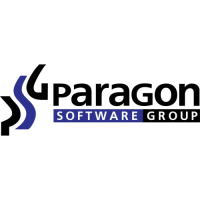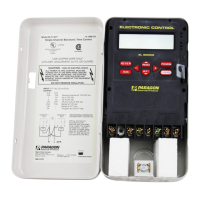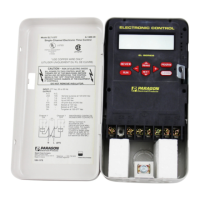
Do you have a question about the Paragon DTC 1000 series and is the answer not in the manual?
| Brand | Paragon |
|---|---|
| Model | DTC 1000 series |
| Category | Controller |
| Language | English |
Illustrates terminal connections for DTC 1000, 800, 600, and 100 series controllers.
Details the roles of the fuse, transformer, controller, thermocouple, relay, and heating elements.
Visualizes how the DTC 1000 controller manages power flow to the heating elements.
Troubleshooting steps for a dead controller display and lack of kiln heat.
Diagnosing issues when the controller powers on but the kiln does not heat.
Addresses slow firing or inability to reach the set temperature.
Troubleshooting guide for specific elements failing to heat up.
How to diagnose and correct inaccurate temperature readings on the controller.
Troubleshooting steps when the kiln reaches temperatures higher than set.
Addresses fluctuating or unstable temperature readings on the controller display.
Solutions for a controller display that freezes or stops updating.
Diagnosing the cause of relay chattering or buzzing sounds.
Investigating why the controller is emitting a beeping sound.
Explains PF or ErrP error codes that appear during the firing process.
Troubleshooting the 'FAIL' error message, often related to thermocouple issues.
Guidance on resetting the controller when the 'Err 0' message appears.
Troubleshooting the 'Err 1' code, often indicating slow firing or element issues.
Testing the wall outlet's voltage supply to ensure it is within the correct range.
Checking the 1.5 amp fuse in the kiln switch box using an ohmmeter.
Verifying if the controller is receiving the correct voltage from the transformer.
Assessing controller input voltage and diagnosing low voltage causes.
Troubleshooting why the kiln does not heat when the controller display is active.
Testing heating elements for continuity using an ohmmeter.
Verifying if the controller is sending voltage to the relays.
Checking the functionality of door or lid interlock switches.
Measuring receptacle voltage while the kiln is drawing power.
Measuring the kiln's amperage draw at the wall receptacle.
Identifying and rectifying loose or corroded electrical connections.
Testing high amperage fuses in kilns with a power connection fuse box.
Visually inspecting elements for heat during a controlled firing cycle.
Diagnosing issues when elements for a relay are not glowing.
Troubleshooting causes for circuit breakers tripping during kiln operation.
Diagnosing blown fuses in heavy amperage kiln connection boxes.
Testing the 1.5 amp fuse and diagnosing short circuits or relay issues.
Testing the resistance of relay coils to identify shorts.
Addressing inaccurate temperature readings due to thermocouple or connections.
Diagnosing fluctuating temperature readings caused by noise or wiring.
Identifying temperature fluctuations linked to relay operation or noise.
Ensuring correct thermocouple installation and checking for wear.
Assessing the wall receptacle's condition for potential grounding issues.
Troubleshooting missing display digits, often due to transformer or wiring errors.
Understanding PF or ErrP errors related to power failures or low voltage.
Troubleshooting the 'FAIL' error, often caused by thermocouple connection issues.
Testing the controller's functionality using a paperclip simulation.
Steps to reset the controller when the 'Err 0' message appears.
Diagnosing Err 1 for slow firing, element problems, or relay issues.
Troubleshooting Err 2, which indicates over-temperature during a hold segment.
Testing relay operation using a 12-volt battery and ohmmeter.
Troubleshooting Err 3, which indicates a temperature drop during a hold segment.
Diagnosing Err 4, related to over-temperature during a cool-down phase.
Addressing Err 6, often caused by incorrect thermocouple wire connections.
Troubleshooting Err 8, indicating slow firing during the last phase of a cone-fire.
Troubleshooting Err B, related to high ambient temperature affecting the controller.
Diagnosing Err d, which indicates a temperature overshoot during heating.
Identifying Err E, H, or t as indicators of a defective controller.
Troubleshooting 'StUC' error for stuck keys or faulty solder joints.











